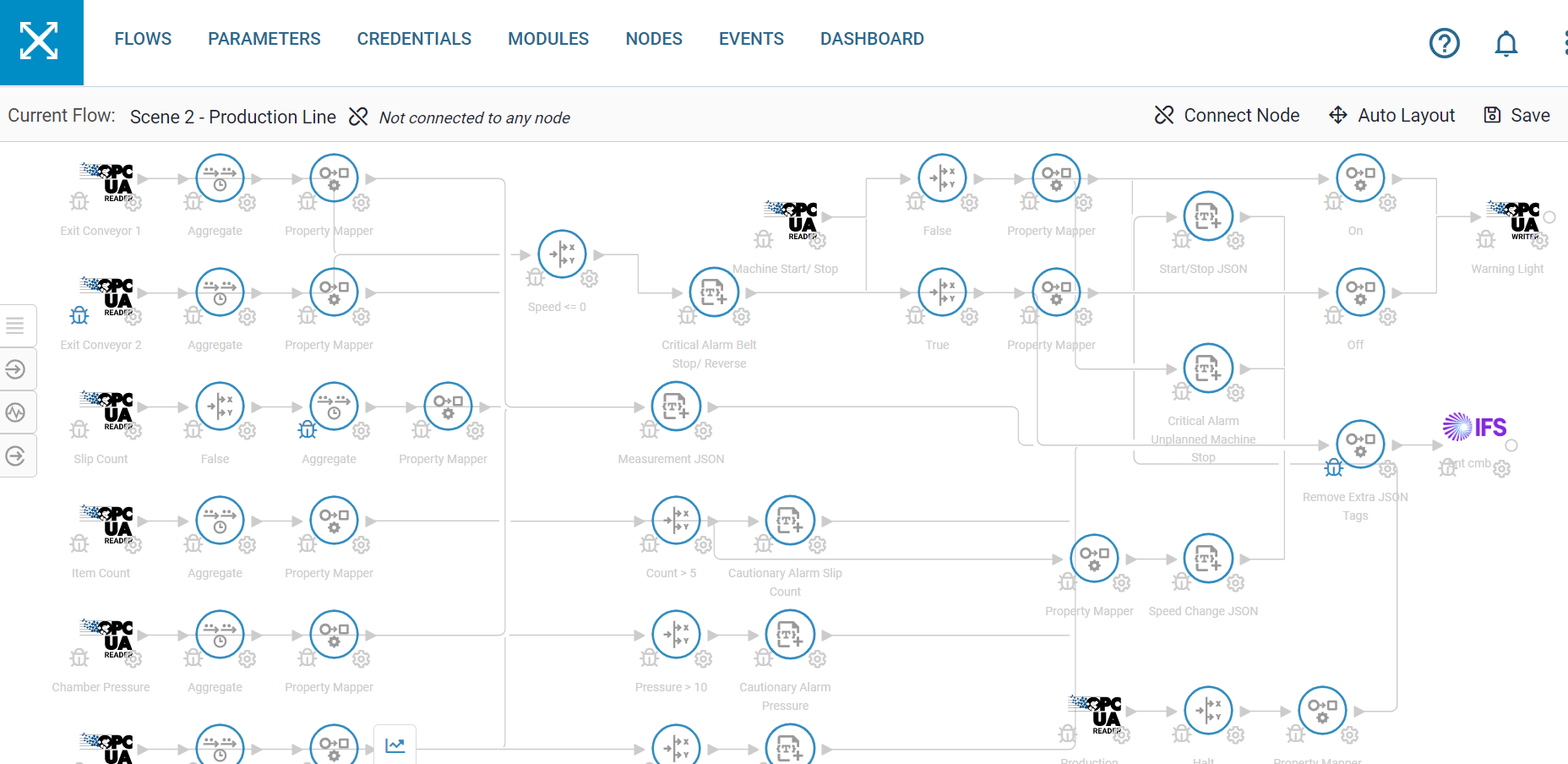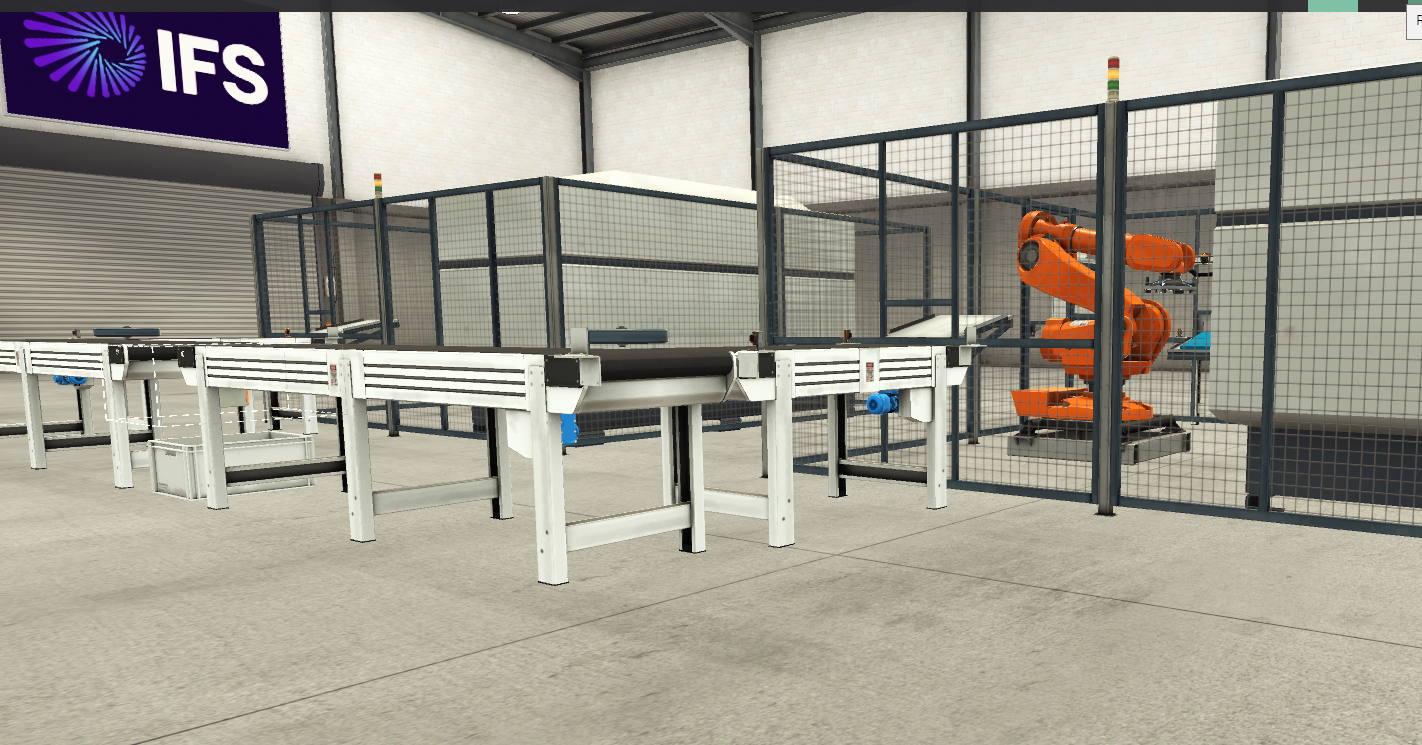IFS Connected Factory - Crosser Edge Analytics Solutions
IFS Connected Factory - Crosser Edge Analytics Solutions¶
Crosser designs and develops streaming analytics, automation, and integration software for edge, on-prem or Cloud. The Crosser platform enables real-time processing of streaming, event-driven or batch data for Industrial IoT (Internet of Things) and Intelligent Workflows. Crosser supports MQTT (MQ Telemetry Transport), OPC UA, Siemens S7 and HTTP common protocols.
Website - https://www.crosser.io/ Documentation - https://support.crosser.io/portal/en/kb/documentation Crosser Support - support@crosser.io Trainings - https://www.crosser.io/academy/
IFS Connected Factory solution offers seamless integration with a factory floor with advanced edge analytics capabilities. IFS has partnered up with a company called Crosser and with their Crosser Edge Analytics solutions data can be analyzed closer to the machine among many things.
Making Big Data Small and Relevant¶
Edge Analytics software allows data produced by sensor-rich assets like machines, equipment and devices to be pre-processed in real-time closer to where it is created.
There are several technical and business drivers and benefits with Crosser Edge Analytics architecture, including:
Cost Savings¶
Significant data reduction by removing dirty data and irrelevant data. Get significant cloud, analytics and network connectivity cost savings.
Innovate with More Data¶
Edge Analytics allows you to collect more data points without increasing your cost of data. More data - more innovation possibilities.
Transform Raw Data to Insights¶
Collect raw data, transform it, analyze it and act on the insights in real-time.
Local Intelligence and Automation¶
Run local triggers between machines or PLC’s with ultra-low latency. Runs autonomously without cloud connectivity.
Edge¶
The Edge Analytics software is deployed on a IoT gateway on a remote unit, or embedded, and processes the sensor data from that single unit.
Field Edge Aggregation¶
Also called Fog Computing. The Edge Analytics software is typically deployed on an IoT gateway and processes the sensor data from multiple field units.
On-Premise Edge¶
Typically on a factory shop floor or building with multiple machines. The Edge Analytics software is installed on a server/virtual machine and processes sensor data from multiple on-premise machines and data sources.
Getting access to relevant data in a central location, either cloud or data center, is the fundamental starting-point to enable these main use-cases and meet the business objectives. Crosser Edge Analytics solution is purpose-built to address the key challenges for Industrial IoT, including:
Factory Floor Challenges¶
- High number of sensor tags - constant changes
- Many data sources: PLC, DCS, MES, Historians and databases
- Many protocols: OPC, Modbus, MQTT, SCADA and more
- Separated networks
- OT and IT team collaboration
Remote Assets Challenges¶
- Moving from basic telemetry to monitoring all subcomponent
- How to collect more data but transfer less?
- Limited and costly connectivity
- Unreliable and intermittent connectivity
- Managing large volume of assets
- Inside customer firewalls
source : Crosser
You need separate licenses in order to use the Crosser Cloud.
Following is the official documentation on Crosser solutions including webinars.
In Crosser Cloud solution flows can be designed which consist of several modules.

Above is a Crosser flow designed for a robotic arm in a factory floor using OPC UA protocol.

Using crosser sensor data can be read and analyzed as well as issue command to the machine it self.
Documentation is available with in each module as well as the mentioned documentation site along with webinars to get you started.
These flows can be designed based on the requirements. Conditions, time intervals, IFS Cloud integration, third party solution integration, machine learning are the some of capabilities which can be achieved using a flow in Crosser Flow Studio.
Flows are deployed in a Edge Node typically a Docker container.
Node Installation¶
IFS Observation Publisher Module¶
The module will create an observation in IFS Cloud using the /int/ifsapplications/projection/v1/IotObservCacheHandling.svc/CreateObservation endpoint.
Universal Connectors¶
Universal Connectors are generic modules used to connect to REST APIs. Using the Universal Connector (UC) wizard you can build your own reusable modules to simplify getting or sending data from/to external APIs when building flows in the Flow Studio. A UC can use settings provided by the user or data from flow messages when building the API calls. You can also provide your own custom icon and documentation for UCs. Once published a UC will look just like any other module in the Flow Studio library. UCs also support versioning, so you can update the module over time and then select the version to use when configuring the module in the Flow Studio editor.
HTTP Listener¶
The module will be used to listen for HTTP requests that is sent to the Crosser server. This module will select messages by using the SourcePath in the Settings.
This module is designed to be located at the start of a flow.
For communication from IFS Cloud to a Crosser Flow can be achieved using this module. From IFS Cloud side either Business Process Automation (BPA) or IFS Connect can be used to invoke the URL.
To set up a HTTP Listener the associated Edge Node need some additional configurations.
Note: communication happens through a port and it is important to check the used port has correct privileges in IFS Cloud deployment side. For example load balancer in Azure can be used to rectify any access issues.
Industrial Protocol Support¶
Crosser provides industrial protocol supported modules like MQTT or OPC UA. These modules can be used to read and write data from and in to a machine in a Crosser flow.
Create Your First IIoT Flow¶
After creating the flow need to deploy to the created Edge Node.
Flow Deployment¶
Refer Crosser documentation for more detailed information.
Solution Architecture¶

In a typical solution there are few components
IoT Device¶
The device that need to extract data and visualize in IFS Cloud and also may issue commands back to it from IFS Cloud
Crosser Flow¶
Designed based on requirements and choosing a correct protocol which used for communication with the device. The flow is designed in the Crosser Flow Studio cloud solution. Flow can consist of modules which use to extract data from the device, time aggregation, conditions, third party solution integration and send observations to IFS Cloud.
Crosser Edge Node¶
The container which the designed flow deployed into. This can be either a Docker container or a windows service. Generally the edge node is situated very close to the machines/ devices for example in a server in the factory floor.
IFS Cloud¶
In IFS cloud actions can be defined as operational or workflow models for incoming observations. Further can have implementation to issue commands to the machine through a Crosser flow.
Frequently Asked Questions (FAQ)¶
How many flows can be deployed to a single edge node? - There are no limits enforced by Crosser. It will accept flows until you run out of resources (CPU/memory) on the machine where the node is deployed.
When upgrading to a newer version of an edge node what happens to already deploy flows in that node? - Existing flows will be started automatically on the new node version
When editing and redeploying a flow; is there a downtime until that flow up and running? - Yes, there is a downtime, corresponding to the time it takes to download the new flow and start it, typically <10s.
What are the offline capabilities in Crosser?
(Ex: if a connected device is offline can Crosser queue up the messages and process that queued messages once the device is back online) - Currently message queuing is achieved by adding the Message Buffer module in front of the output modules. This module then looks at the 'crosser.success' output from the output module and will retry the message until it was successfully delivered or the specified number of retries are exhausted. With the next node release (2.6) this capability will be integrated with all modules and can be enabled on any output module.